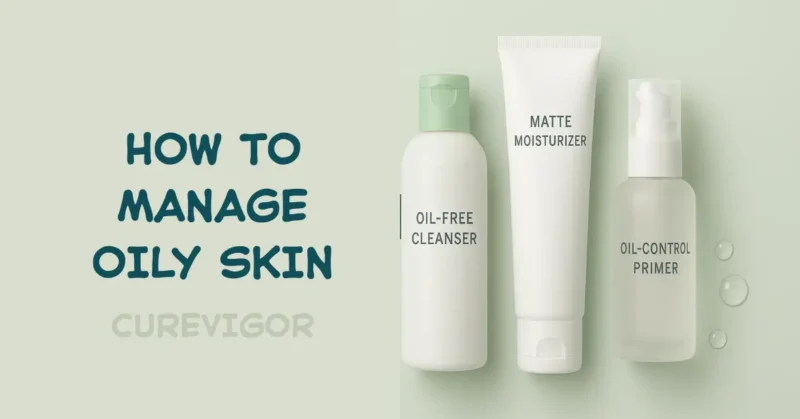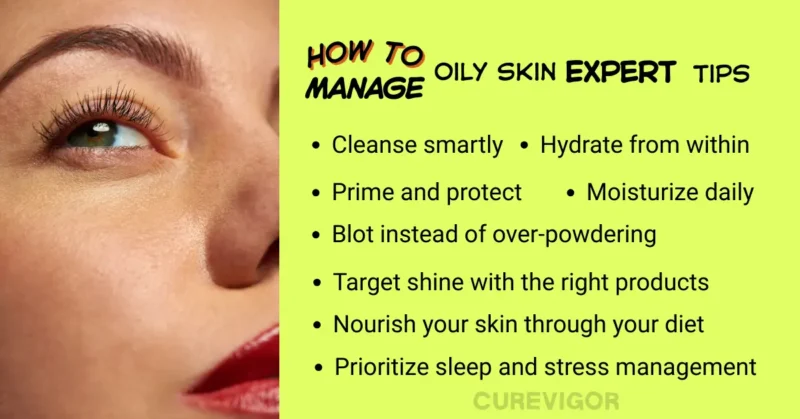Struggling with oily skin? Discover expert-backed skincare routines, product recommendations, and lifestyle adjustments to effectively manage shine and achieve a balanced, matte complexion.
Thank you for reading this post, don't forget to subscribe!How to Manage Oily Skin: Expert Tips for a Fresh, Matte Look
Oily skin can result in constant shine, enlarged pores, and makeup that tends to shift. However, you can manage excess oil and keep your skin looking fresh and matte all day long with targeted routines and wise product selections.
Managing oily skin involves adopting a good skincare routine, using oil-free products, and making healthy lifestyle adjustments. Here’s how to get started.
Understanding Oily Skin
Causes of Oily Skin
When the sebaceous glands generate more sebum than the skin requires, oily skin results. Although sebum is a natural oil that hydrates and protects the face, excessive sebum production can clog pores and cause shine. Here are the most common reasons oily skin occurs:
- Genetics and family history: If oily skin runs in your family, there’s a high chance you’ll inherit it too. People with genetically larger or more active sebaceous glands naturally produce more sebum, also known as oil. Although you cannot alter this, you may control it with the right skincare regimen.
- Hormonal fluctuations: Hormones, particularly androgens, play a huge role in stimulating oil production. This is why oily skin often appears during puberty, but flare-ups can also occur around menstruation, pregnancy, or during periods of stress. Adults with hormonal imbalances, such as those related to PCOS (polycystic ovary syndrome), may also experience persistent oiliness.
- Environmental factors: Climate can significantly affect how oily your skin feels. Hot, humid environments encourage sebaceous glands to produce more oil, making your skin appear greasier. However, to compensate for dehydration, the skin may produce more oil in colder or drier areas.
- Skincare habits and products: Ironically, over-cleansing or using harsh, drying products can have the opposite effect. Excessive oil removal can cause your sebaceous glands to release even more sebum, which may make your skin appear even more radiant.
- Diet and lifestyle: Foods high in sugar, dairy, and processed fats may trigger excess oil and breakouts in some people. Poor sleep, high stress levels, and dehydration can also disrupt hormone balance, leading to increased sebum production.
Characteristics of Oily Skin

Oily skin has distinct features that set it apart from other skin types. If you notice these signs, chances are you fall into the oily skin category:
- Persistent shine: A greasy film often returns within hours of cleansing, especially on the T-zone (forehead, nose, and chin), making makeup wear off quickly.
- Enlarged, visible pores: Individuals with oily skin types often have larger pores, particularly on the cheeks and nose. Breakouts may result from these pores’ increased propensity to gather debris, germs, and dead skin cells.
- Blackheads and whiteheads: Excess oil mixes with dead skin cells, clogging pores and creating blackheads (open comedones) and whiteheads (closed comedones). These are some of the most common issues oily skin owners face.
- Frequent acne flare-ups: Because clogged pores are a breeding ground for bacteria, oily skin is often acne-prone. Breakouts can range from mild pimples to painful cystic acne if oil production is excessive.
- Thicker skin texture: Oily skin often feels thicker or rougher to the touch compared to dry or normal skin. While this can reduce the appearance of fine lines, it also increases the likelihood of congestion and dullness.
- Makeup struggles: Oily skin can make it challenging to keep foundation and powder looking fresh, as shine tends to break through quickly.
Expert Tips for Managing Oily Skin

A. Cleanse Your Skin Properly
Cleansing is the foundation of oily skin care, but doing it incorrectly can exacerbate the problem.
- Use a gentle, oil-free cleanser by choosing gel-based or foaming formulas with ingredients such as salicylic acid, tea tree oil, or niacinamide, which help remove oil effectively. Avoid cleansers with sulfates or alcohol, as these can strip skin and lead to rebound oil production.
- Don’t over-wash your face: Washing more than twice a day often backfires. The skin senses dryness and goes into “rebound mode,” producing more sebum to compensate. Stick to morning and evening cleanses, and if you need a midday refresh, use micellar water or blotting paper instead of another full wash.
- Exfoliate smartly: Regular exfoliation helps keep pores clear and minimize blackheads, but overexfoliating can irritate oily skin. Choose chemical exfoliants (like AHAs or BHAs) 2–3 times a week rather than harsh physical scrubs, which can cause micro-tears and increase oiliness.
Pro Tip: Double cleansing at night—using an oil-based cleanser first, followed by a water-based gel—can remove sunscreen, pollution, and makeup thoroughly without over-drying.
B. Use Oil-Control Products
Targeted products can help regulate shine throughout the day.
- Choose products labeled as “non-comedogenic” and “oil-free,” as these are less likely to add shine or clog pores. Avoid creams with heavy oils such as coconut oil or mineral oil, which can contribute to breakouts.
- Look for active ingredients:
- Salicylic acid penetrates deeply into pores, dissolving oil and reducing the appearance of blackheads.
- Benzoyl peroxide targets acne-causing bacteria while also drying up excess oil.
- Niacinamide (Vitamin B3) helps reduce inflammation and control oil production.
- Clay masks (like kaolin or bentonite), once or twice a week, can absorb oil and detoxify the skin.
- Select alcohol-free toners containing ingredients like witch hazel, green tea, or rose water, which help refresh skin and balance oil without irritation. Steer clear of toners with a high alcohol content, as they can cause your skin to become both oily and dry.
Pro Tip: Don’t layer too many “oil-control” products at once. It may dry out the skin, leading to rebound oiliness. Select one or two targeted treatments and build your approach around them.
C. Moisturize Wisely
Failing to use moisturizer is one of the most common mistakes made by people with oily skin.
- Lightweight hydration is key: Opt for gel-based moisturizers with hyaluronic acid or glycerin. They lock in hydration without sitting heavily on the skin.
- Avoid heavy creams: Thick lotions or balms can clog pores and make skin appear shinier. Choose fast-absorbing, water-based formulas instead.
- Balance oil, don’t eliminate it: Dehydrated Skin produces even more sebum to compensate. A good moisturizer helps keep your skin barrier healthy and reduces the overcompensation cycle.
Pro Tip: Try moisturizers with aloe vera or green tea extract for their soothing and anti-inflammatory benefits, as well as hydration.
D. Use a Primer
If you wear makeup, a primer can make a world of difference for oily skin.
- Select primers with oil-absorbing ingredients such as silica, kaolin clay, or mattifying polymers for instant shine control. Avoid primers with a dewy or luminous finish, as these can increase the appearance of oil.
- Extend makeup wear: Primers create a smooth barrier between skin and foundation, preventing oils from breaking down your makeup too quickly.
- Target the T-zone: Apply primer only where you get oily the most (forehead, nose, chin). Using it all over may dry out non-oily areas and cause patchiness.
Pro Tip: Some primers contain skincare ingredients like niacinamide or salicylic acid, which can also serve as oil-control treatments.
E. Blotting Papers
Blotting papers are one of the simplest and most effective tools for maintaining a matte finish throughout the day.
- Instant oil control: Unlike powders, blotting sheets absorb oil without adding extra product to the skin. This prevents a cakey look while keeping shine at bay.
- On-the-go friendly: Keep a pack in your bag, desk drawer, or car for quick touch-ups.
- Choose wisely: Some blotting papers are infused with green tea or rice powder for added antibacterial and calming benefits.
Pro Tip: Gently press the sheet against oily areas—don’t rub, as this can spread oil and disrupt your makeup.
F. Makeup Tips for Oily Skin
Applying makeup to oily skin requires a different approach than using it on dry or normal skin.
- Choose the right base: Look for oil-free, long-wear foundations with a matte or semi-matte finish. Avoid dewy formulas that can amplify shine.
- Set strategically: Use a fine, translucent setting powder to lock in your foundation. Focus on the T-zone rather than applying a heavy layer all over your face.
- Layer lightly: Less is more when it comes to makeup for oily skin. Heavy layers of foundation, concealer, and powder can mix with sebum, leading to patchiness or clogged pores.
- Consider setting sprays: Using a mattifying setting spray can help your makeup last longer and leave your skin feeling smoother.
Pro Tip: Try applying foundation with a damp sponge—it helps press the product into the skin for a natural matte look that lasts longer.
Additional Tips
A. Stay Hydrated
Hydration is one of the most often overlooked aspects of skincare, particularly for individuals with oily skin types. Many assume that since their skin produces excess oil, it doesn’t need hydration, but this is a misconception.
- Water vs. oil balance: Oily skin can still be dehydrated. When the body lacks water, the skin compensates by producing more sebum. Drinking an adequate amount of water—about 8 to 10 glasses daily—keeps the skin hydrated at a cellular level, which reduces the signal for sebaceous glands to overproduce oil.
- Flush out toxins: Sufficient hydration facilitates the body’s natural detoxification mechanisms, helping to eliminate impurities that could otherwise show up on the skin as excess oil or acne.
- Avoid dehydrating drinks: Be mindful of beverages like coffee, energy drinks, and sodas. These contain caffeine and sugar, which can dehydrate the body and cause an oil imbalance in the skin. Herbal teas and water flavored with lemon or cucumber are better choices for hydration and maintaining clear skin.
B. Eat a Balanced Diet
Your skin’s behavior is strongly influenced by what you put on your plate. A balanced diet not only helps regulate oil production but also promotes long-term skin health.
- Reduce greasy and processed foods: Fried foods, fast food, and highly processed snacks increase inflammation and can worsen oil production. They often contain unhealthy fats that disrupt hormonal balance, leading to breakouts.
- Focus on omega-3 fatty acids: Foods rich in omega-3s, such as salmon, mackerel, flaxseeds, and walnuts, help regulate oil levels and reduce inflammation in the skin. This promotes a calmer, clearer complexion.
- Choose low-glycemic foods: High-glycemic foods such as white bread, pastries, and sugary treats spike blood sugar, which increases androgen activity and stimulates oil production. Opt for whole grains, fresh fruits, and vegetables to maintain a balanced skin.
- Add antioxidant-rich foods: Antioxidants found in berries, leafy greens, and green tea help fight free radicals and reduce skin tension, which in turn lowers the risk of breakouts and excess oil.
C. Get Enough Sleep
Sleep is the time when your body resets and repairs itself, and your skin is no exception. Skimping on rest can lead to hormonal imbalances, which directly affect oil production.
- The link between sleep and oiliness: Poor or irregular sleep increases cortisol (the stress hormone), which stimulates sebaceous glands. Over time, this results in more shine, clogged pores, and frequent breakouts.
- Aim for quality rest: Seven to eight hours of deep, uninterrupted sleep each night gives the skin time to regenerate, balance oil levels, and repair daily damage caused by environmental stressors.
- Establish a consistent routine: Going to bed and waking up at the same time every day helps regulate your circadian rhythms and hormonal balance, both of which significantly influence skin health.
- Support sleep quality naturally: Keep electronics out of the bedroom, dim lights before bed, and avoid caffeine late in the day. A simple wind-down routine—such as reading or practicing breathing exercises—can enhance sleep quality and, in turn, improve skin health.
The Bottom Line on Managing Oily Skin
Managing oily skin is not about eliminating oil—it’s about balance, consistency, and choosing habits that work with your skin, not against it. With the right approach, you can keep shine under control and enjoy a clear, matte, and healthy complexion.
Key takeaways to remember:
- Cleanse smartly: Use a gentle, oil-free cleanser twice a day. Avoid over-washing to prevent rebound oiliness.
- Target shine with the right products: Choose non-comedogenic, oil-control formulas with proven ingredients like salicylic acid, niacinamide, or clay.
- Moisturize daily: Hydration is essential, even for oily skin. Lightweight, water-based moisturizers keep skin balanced.
- Prime and protect: A mattifying primer and oil-free makeup help maintain a shine-free look throughout the day.
- Blot instead of over-powdering: Blotting papers remove excess oil instantly without clogging pores or disturbing makeup.
- Hydrate from within: Drink enough water and avoid sugary or caffeinated drinks to reduce internal triggers of excess oil.
- Nourish your skin through your diet: Limit greasy foods, choose omega-3-rich meals, and incorporate antioxidants to help regulate oil production and maintain healthy skin.
- Prioritize sleep and stress management: Quality rest and reduced stress help stabilize hormones and naturally minimize oiliness.
Final Thought: Oily skin can be effectively managed with patience and a proper skincare routine. By combining smart skincare habits with lifestyle choices, you can transform oily skin into a complexion that feels fresh, looks matte, and glows with health—not grease.
Ready to take control of your oily skin? Implement these professional suggestions immediately by selecting the best oil-free products, maintaining a consistent skincare regimen, and making minor lifestyle adjustments that can have a significant impact. A shine-free, matte, and confident look is just a routine away.
Get more Health & Beauty Tips.
You might like:

